
The Royal Greenhouse of Laeken
Brussels, Belgium, 1874, Architect: Alphonse Balat (1818 - 1895)
According to authors Alan Stein and Nancy Virts in their book, The Conservatory: Gardens Under Glass, “British architectural and engineering pioneers like John Claudius Loudon, Charles Lanyon, Richard Turner, and Joseph Paxton imagined and realized astonishing structures that appeared to be spun from glass. The technological innovations of the Industrial Revolution seemed to have removed all limits to human creativity.” The royal greenhouses in Belgium are a prime example.
When Belgium first achieved its independence in 1831, its first king Leopold I (1790-1865) was favored for his various talents and diplomatic skills. His predecessor, son Leopold II, built on his legacy when he took the throne, contributing to the transformation of Belgium’s major cities, which became architectural showplaces that could rival Paris and Vienna. Kew Gardens was Leopold’s inspiration when he set out to transform the gardens at his royal residence, but whereas Kew was an enterprise separate from Britain’s royal palaces, at Laeken the greenhouses and conservatories were conceived as an integral part of the palace itself, complete with chapel, reception rooms, and floral arcades to lead guests into the breathtaking conservatory that is the Winter Garden.
As Alan and Nancy write, “...in creating a monumental stage and theater on which to display his collection of plants, especially those from Africa, the king was motivated, like his noble peers, to dazzle and impress. Foreign dignitaries might have had the impression that they were entering an enchanted fairy-tale castle.” The modest beginnings of the Laeken gardens started with a columned neoclassical stone orangery in 1817.
Leopold commissioned Alphonse Balat (1818-1895) to design and construct the greenhouses for his collection of exotic plants from Africa. Alan and Nancy describe Balat’s early work in The Conservatory: Gardens Under Glass as “...somewhat old-fashioned, resembling more the sober, unadorned neoclassical architecture of the first decades of the nineteenth century than the exuberantly decorated medieval revivalism that had become increasingly popular. Like the English contemporaries, the classically trained Balat soon embraced the new construction methods and materials, iron and glass.” Twenty years in construction, the Royal Greenhouses of Laeken would eventually house a world-famous botanical collection in 270,000 square feet of interconnected glass pavilions.
Today, the collection has an exceptional triple value, containing plants belonging to the original plantations of King Leopold II and other rare plants from around the world. Each year, the greenhouses open to the public for three weeks in the Spring. To learn more about the incredible history of the Royal Greenhouses at Laeken, order a copy of The Conservatory: Gardens Under Glass!
Photo Credits: Alan Stein (Heading + Sliders), Emma Thomson | Fldners (Single Image)



![04_Cons_ch4_042[1B]_copyright.jpg](https://images.squarespace-cdn.com/content/v1/5f11b7e4e3277041fd2580c6/11de5324-8449-461c-a6d8-7e1765e326ed/04_Cons_ch4_042%5B1B%5D_copyright.jpg)
![04_Cons_ch4_044[2B]_copyright.jpg](https://images.squarespace-cdn.com/content/v1/5f11b7e4e3277041fd2580c6/86eef547-ccd5-4f11-8eb2-8108692d6013/04_Cons_ch4_044%5B2B%5D_copyright.jpg)
![04_Cons_ch4_045[3B]_copyright.jpg](https://images.squarespace-cdn.com/content/v1/5f11b7e4e3277041fd2580c6/c35afa26-7e49-4082-bf4d-774c2b51def6/04_Cons_ch4_045%5B3B%5D_copyright.jpg)
![04_Cons_ch4_046[3C]_copyright.jpg](https://images.squarespace-cdn.com/content/v1/5f11b7e4e3277041fd2580c6/103166b1-c201-4e3a-981d-65d0999641d5/04_Cons_ch4_046%5B3C%5D_copyright.jpg)
![04_Cons_ch4_047[2B]_copyright.jpg](https://images.squarespace-cdn.com/content/v1/5f11b7e4e3277041fd2580c6/d5e2bc9f-c228-4dd4-b937-62d2d510bc7d/04_Cons_ch4_047%5B2B%5D_copyright.jpg)